Elements of the charge
The model of what the charge of the legion may have looked like is based on three fundamental building blocks. They are: how fast did the soldiers march and run, how far and at what distance could the pila have been thrown, and how far apart did the ranks and files need to be during the charge.
Cadence of the march and run
The march cadence is fairly well established. The Roman militari gradu, regular march cadence, was 100 paces per minute, the quick march cadence was 120 paces per minute. The Roman foot was 0.9708 English foot. The pace was 2.5 Roman feet, 29.124". According to Upton, this is almost exactly the same as the US Army standard at the turn of the century; its pace was 30", the regular march cadence was 100 paces / minute and the quick march cadence was 120 paces / minute.
The pace of the running charge is unknown, and surely varied considerably from battle to battle according to the terrain. The running pace used in the model was derived from some modern data from a variety of sources. A "pace" is the interval between left and right heel strikes, a "step" is the interval between strikes of the same foot. There are two paces to the step.
The 1900 Olympic 200 meter race was run at the speed of about 10.5 seconds per hundred meters. Modern sprinters in the 100 meter dash average about 4.5 steps per second, in the longer races such as the 1500 meter, they average about 3.5 paces per second. A survey of men jogging on a treadmill shows an average running rate of 2.7 paces per second with an average of 1.07m (42") per pace. The men surveyed averaged between 5’8" and 6’1" tall.
The Roman soldier was running in formation, over uneven ground, carrying arms, wearing armor, and in the process both throwing his pilum and avoiding oncoming missiles. For modeling purposes I used 3 paces of 40" per second for the charge, less than runners in even long distance races but faster than a jog.
In the drawing below, the box on the left shows the standard Roman army quick march cadence. There are two steps per second, each step is 30" from heel to heel. They would march 91.44m (100 yards) in one minute. The box on the right shows a running cadence. There are three steps per second, each is 40" long. They would run 91.44m (100 yards) in 30 seconds. These are the cadences used in the model of the attack.
Range of the pilum
The next element to work out where in the attack the pila might have been thrown by each rank. Authors give a wide range of distances for the pilum, from a high of 27.43m (90’) to a low 7.62m (25’). One even puts it as low as 4.87m (16’) but this seems wholly unreasonable.
The estimated weight of the pilum also varies widely. One author estimates the weight at 8.62kg (19 Lb.), another at 4.99kg (11 Lb.). Spears and pikes in museums, of similar length but different construction, weight between 1.59kg (3.5Lbs.) to 2.5kg (5.5 Lb.). Calculations based on an accurately drawn model and using typical densities for iron and wood give a weight of about 4.9 pounds. The weight added to imperial pila probably doubled the overall weight.
Although some authors say that a throwing strap was used, most disagree. The soldier used his pilum during the last few seconds of the charge while running over uneven ground, keeping his spacing with his comrades, and dodging enemy missiles. Furthermore, he had to be able draw his sword immediately upon release or upon dropping the pilum. A throwing strap would seem like an unwelcome and even dangerous encumbrance. The model is based on the use of the pilum without a throwing strap.
Modern javelin throws provide some data about distance.
In the 1908 Olympics, the winning javelin throw was 54.25m (178’) for a javelin weighing less than a kilogram (two pounds). Modern records are much greater, but the earlier record is probably a better indicator of range for these purposes. A throw of 178 feet at a launch angle of about 35 degrees would require an initial velocity of 77 feet per second. If the person were running at about 6.5 miles per hour that contributes just under 10 feet per second to the velocity. The throw itself, then, must generate about 67 feet per second. A professional baseball pitcher can throw a fastball at 92 MPH, about 135 feet per second. The javelin throw is roughly half that.
If the gold medal throw in 1908 was only 54 meters (178 feet), then the average throw of the heavier pilum must have been much less. A rough estimate would be that the average distance a pilum of 2.5kg (5 Lb.), twice the weight of a modern javelin, could be thrown would be about 22.5m (74’).
For more information on trajectory paths please see the Trajectory calculator.
The angle for a standing throw that achieves the maximum distance 45 degrees. However if the soldier is charging at 10 feet per second then the theoretically optimum angle is 47 degrees. In reality, throwing at this steep angle feels awkward; it is more natural to throw at a lower angle, something between 30 and 40 degrees. According to a university sports physiologist, modern javelins are thrown at angles between 35 and 40 degrees, not higher. Using the same force, the distances of a 47 degree throw and a 30 degree throw are shown in the drawing above.
Running and standing throws
The range of 74 feet is based on a running throw in which the speed of the runner is added to the speed of the throw to increase the range. Were the same throw to be done from a stationary position then the range would be less.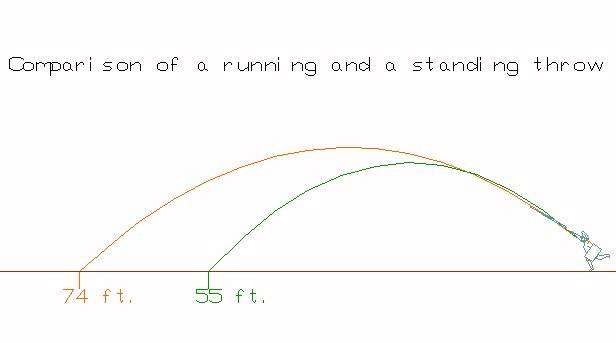
Uphill and downhill throws
Caesar mentions the advantage achieved by throwing missiles from the higher ground. One good reason would have been the greater distance the pilum could be thrown. The drawing below shows the distances reached by a strong throw and a weak throw both uphill and downhill. The difference between a well thrown pilum downhill and a poorly thrown pilum uphill is 9.7m (32’), giving a significant advantage to those on the high ground. The slopes of the inclines are 6 degrees.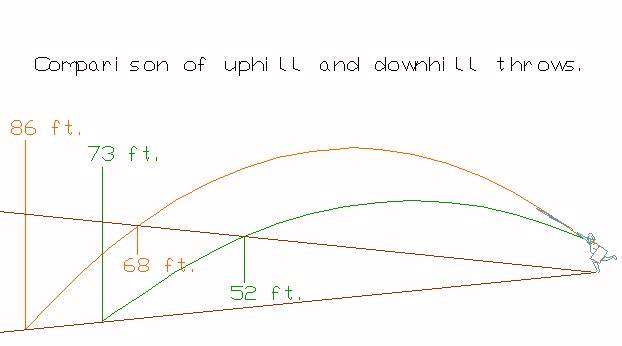
Strong and weak throws
Not every throw could have been at or even near the maximum. A weak throw would be one with less force behind it and/or one thrown at a lower angle. The drawing below shows a strong throw at the optimum angle and a weaker throw at a lower trajectory.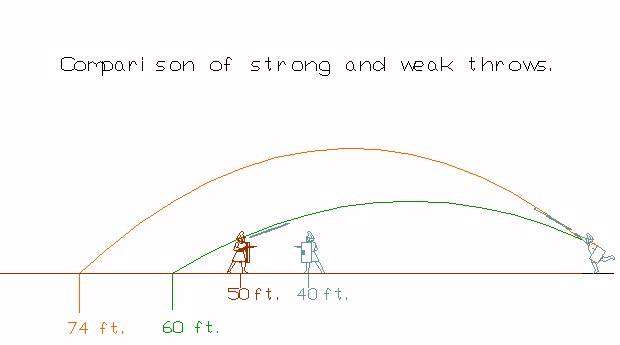
Using the above data, the maximum would be about 25.5m (74’) and the low end of the average about 18.25 (60’).
In considering how far away the pilum would have been thrown there are two other factors to consider.
Although a strong throw might reach 74 feet to the ground, it needed to strike the enemy soldier chest high. At a range of 15.2m (50’) the pilum would be about 1.5 m (5’) from the ground, still high enough to strike the enemy soldier. The effective range, then, would be between 25.5m and 15m.
The second consideration is safety. A strong throw might reach 74 feet but the critical concern would be the weaker throws. For those in the rear ranks, their throws needed to clear the heads of the soldiers in front. At a distance of 12m (40’) the poorly thrown pilum clears about 2.64m (8’8"). This would be a good distance for the rear ranks to use in throwing their pila. The effective range of the pilum would be between 15m (50’) and 22.5m (74’). At these distances, if a pilum were to strike and stick in the enemy’s shield at 15m the butt of the pilum would clear the front rank by about a meter, a marginally safe distance but probably still disconcerting to the front line soldier.
The models of the charge have the pila being released at no more than 60 feet from the enemy and, for those in the rear ranks, no less than 40’ from the first rank.
Spacing between ranks
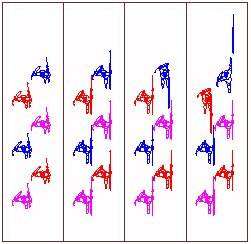 This drawing shows the difficulty with spacing if the close spacing of the files for the march is maintained during the attack. On the far left the six ranks are shown on 4’ spacing as they could have been in a marching formation. If all six ranks began to run simultaneously, maintaining the same 4’ spacing (second frame), the there is very little clearance for the pilum. In the third frame the soldier in the first rank is extending his arm back in preparation for the throw. There are only about 20" between the butt of his pilum and the chest of the soldier behind him in the 3rd rank. The tip of the pilum in the 3rd rank overlaps the but of the one in the first rank. With any amount of jostling during the charge the two could easily bump, disrupting the throw of the soldier in the first rank. And these drawing suppose a staggered formation in which each file is offset from the one in front. Were the files aligned the pilum could not be swung back at all.
This drawing shows the difficulty with spacing if the close spacing of the files for the march is maintained during the attack. On the far left the six ranks are shown on 4’ spacing as they could have been in a marching formation. If all six ranks began to run simultaneously, maintaining the same 4’ spacing (second frame), the there is very little clearance for the pilum. In the third frame the soldier in the first rank is extending his arm back in preparation for the throw. There are only about 20" between the butt of his pilum and the chest of the soldier behind him in the 3rd rank. The tip of the pilum in the 3rd rank overlaps the but of the one in the first rank. With any amount of jostling during the charge the two could easily bump, disrupting the throw of the soldier in the first rank. And these drawing suppose a staggered formation in which each file is offset from the one in front. Were the files aligned the pilum could not be swung back at all.
In these drawings the ranks are assigned different colors to make it easier to distinguish the activities of each.
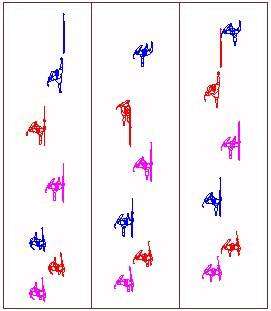 One solution to this problem is to think of the ranks as starting the charge one after the other instead of simultaneously. Each rank gets a head start on those behind it. In the model on the right this technique opens 9 feet between ranks by the time the pila are thrown. The next section shows the development of this spacing.
One solution to this problem is to think of the ranks as starting the charge one after the other instead of simultaneously. Each rank gets a head start on those behind it. In the model on the right this technique opens 9 feet between ranks by the time the pila are thrown. The next section shows the development of this spacing.
It would seem more natural for everyone to start charging at once. For that to work it would seem that the ranks would have to start with a greater spacing between them during the march. This would be a much looser formation, less cohesive.
The model of the charge in the next section is based on a staggered start.

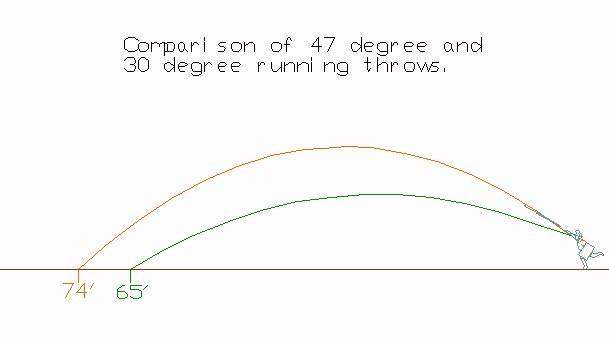
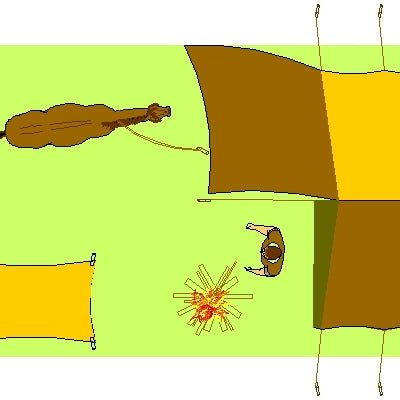
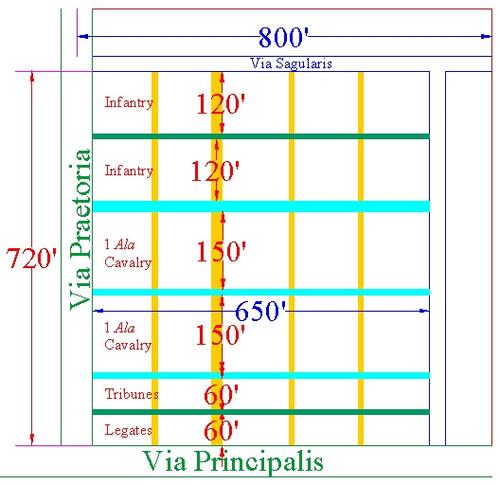
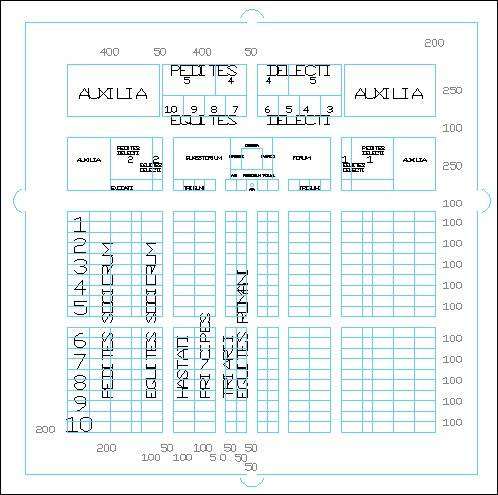
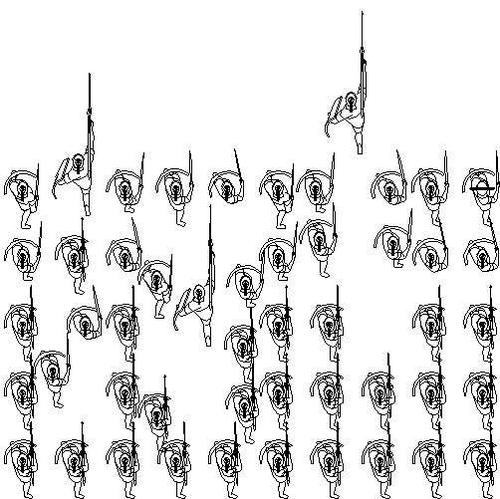
1 comment
I have seen a re-enactment by a young javelin thrower and it was clear that wearing armour significantly affected distance thrown and that also carrying a shield not only reduced distance still further, but made it difficult to throw on the run at all. While Romans might have trained to do this, running over uneven ground would cause additional difficulties, especially when carrying a shield. I recall also Caesar talking about throwing down a slope; running downhill with armour, shield and pilum sounds like yet more problems.